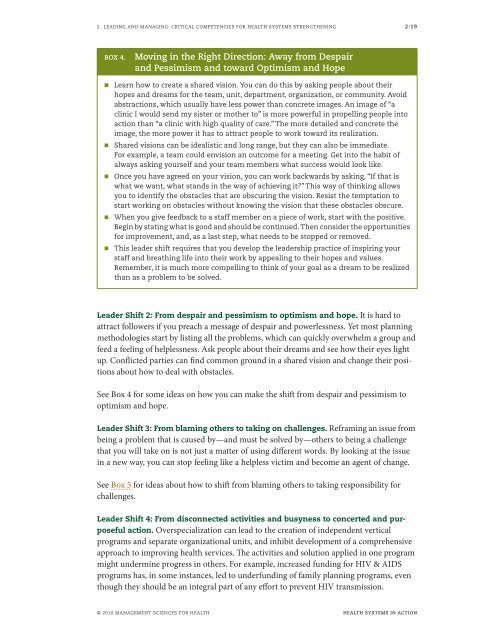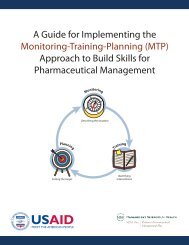Health Systems in Action: an eHandbook for Leaders and Managers
Health Systems in Action: an eHandbook for Leaders and Managers
Health Systems in Action: an eHandbook for Leaders and Managers
You also want an ePaper? Increase the reach of your titles
YUMPU automatically turns print PDFs into web optimized ePapers that Google loves.
2. LeADiNG AND MANAGiNG: CRitiCAL COMPeteNCieS fOR heALth SYSteMS StReNGtheNiNG 2:19<br />
BoX 4. Mov<strong>in</strong>g <strong>in</strong> the Right Direction: Away from Despair<br />
<strong>an</strong>d Pessimism <strong>an</strong>d toward optimism <strong>an</strong>d Hope<br />
■■ Learn how to create a shared vision. You c<strong>an</strong> do this by ask<strong>in</strong>g people about their<br />
hopes <strong>an</strong>d dreams <strong>for</strong> the team, unit, department, org<strong>an</strong>ization, or community. Avoid<br />
abstractions, which usually have less power th<strong>an</strong> concrete images. An image of “a<br />
cl<strong>in</strong>ic i would send my sister or mother to” is more powerful <strong>in</strong> propell<strong>in</strong>g people <strong>in</strong>to<br />
action th<strong>an</strong> “a cl<strong>in</strong>ic with high quality of care.” the more detailed <strong>an</strong>d concrete the<br />
image, the more power it has to attract people to work toward its realization.<br />
■■ Shared visions c<strong>an</strong> be idealistic <strong>an</strong>d long r<strong>an</strong>ge, but they c<strong>an</strong> also be immediate.<br />
<strong>for</strong> example, a team could envision <strong>an</strong> outcome <strong>for</strong> a meet<strong>in</strong>g. Get <strong>in</strong>to the habit of<br />
always ask<strong>in</strong>g yourself <strong>an</strong>d your team members what success would look like.<br />
■■ Once you have agreed on your vision, you c<strong>an</strong> work backwards by ask<strong>in</strong>g, “if that is<br />
what we w<strong>an</strong>t, what st<strong>an</strong>ds <strong>in</strong> the way of achiev<strong>in</strong>g it?” this way of th<strong>in</strong>k<strong>in</strong>g allows<br />
you to identify the obstacles that are obscur<strong>in</strong>g the vision. Resist the temptation to<br />
start work<strong>in</strong>g on obstacles without know<strong>in</strong>g the vision that these obstacles obscure.<br />
■■ When you give feedback to a staff member on a piece of work, start with the positive.<br />
Beg<strong>in</strong> by stat<strong>in</strong>g what is good <strong>an</strong>d should be cont<strong>in</strong>ued. then consider the opportunities<br />
<strong>for</strong> improvement, <strong>an</strong>d, as a last step, what needs to be stopped or removed.<br />
■■ this leader shift requires that you develop the leadership practice of <strong>in</strong>spir<strong>in</strong>g your<br />
staff <strong>an</strong>d breath<strong>in</strong>g life <strong>in</strong>to their work by appeal<strong>in</strong>g to their hopes <strong>an</strong>d values.<br />
Remember, it is much more compell<strong>in</strong>g to th<strong>in</strong>k of your goal as a dream to be realized<br />
th<strong>an</strong> as a problem to be solved.<br />
Leader Shift 2: From despair <strong>an</strong>d pessimism to optimism <strong>an</strong>d hope. It is hard to<br />
attract followers if you preach a message of despair <strong>an</strong>d powerlessness. Yet most pl<strong>an</strong>n<strong>in</strong>g<br />
methodologies start by list<strong>in</strong>g all the problems, which c<strong>an</strong> quickly overwhelm a group <strong>an</strong>d<br />
feed a feel<strong>in</strong>g of helplessness. Ask people about their dreams <strong>an</strong>d see how their eyes light<br />
up. Conflicted parties c<strong>an</strong> f<strong>in</strong>d common ground <strong>in</strong> a shared vision <strong>an</strong>d ch<strong>an</strong>ge their positions<br />
about how to deal with obstacles.<br />
See Box 4 <strong>for</strong> some ideas on how you c<strong>an</strong> make the shift from despair <strong>an</strong>d pessimism to<br />
optimism <strong>an</strong>d hope.<br />
Leader Shift 3: From blam<strong>in</strong>g others to tak<strong>in</strong>g on challenges. Refram<strong>in</strong>g <strong>an</strong> issue from<br />
be<strong>in</strong>g a problem that is caused by—<strong>an</strong>d must be solved by—others to be<strong>in</strong>g a challenge<br />
that you will take on is not just a matter of us<strong>in</strong>g different words. By look<strong>in</strong>g at the issue<br />
<strong>in</strong> a new way, you c<strong>an</strong> stop feel<strong>in</strong>g like a helpless victim <strong>an</strong>d become <strong>an</strong> agent of ch<strong>an</strong>ge.<br />
See Box 5 <strong>for</strong> ideas about how to shift from blam<strong>in</strong>g others to tak<strong>in</strong>g responsibility <strong>for</strong><br />
challenges.<br />
Leader Shift 4: From disconnected activities <strong>an</strong>d busyness to concerted <strong>an</strong>d purposeful<br />
action. Overspecialization c<strong>an</strong> lead to the creation of <strong>in</strong>dependent vertical<br />
programs <strong>an</strong>d separate org<strong>an</strong>izational units, <strong>an</strong>d <strong>in</strong>hibit development of a comprehensive<br />
approach to improv<strong>in</strong>g health services. The activities <strong>an</strong>d solution applied <strong>in</strong> one program<br />
might underm<strong>in</strong>e progress <strong>in</strong> others. For example, <strong>in</strong>creased fund<strong>in</strong>g <strong>for</strong> HIV & AIDS<br />
programs has, <strong>in</strong> some <strong>in</strong>st<strong>an</strong>ces, led to underfund<strong>in</strong>g of family pl<strong>an</strong>n<strong>in</strong>g programs, even<br />
though they should be <strong>an</strong> <strong>in</strong>tegral part of <strong>an</strong>y ef<strong>for</strong>t to prevent HIV tr<strong>an</strong>smission.<br />
© 2010 MANAGeMeNt SCieNCeS fOR heALth HeAltH SySteMS In ACtIon










